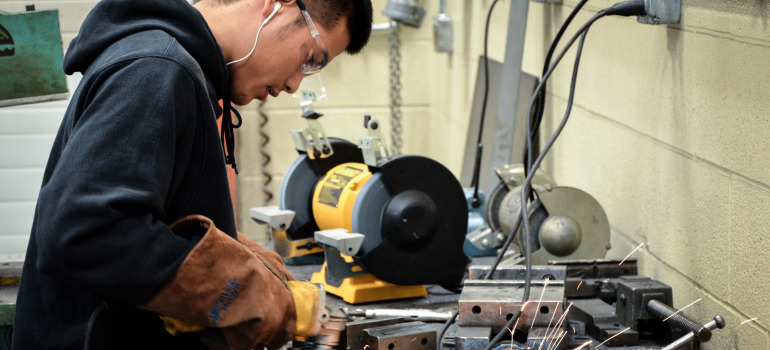Indiana is the most manufacturing-dependent state in the nation, and the industry continues a strong rebound from the Great Recession.
However, a survey released by Katz, Sapper & Miller and authored by the Indiana University Kelley School of Business in Indianapolis warns that growth could be derailed by regulatory costs and workforce weaknesses.
“Manufacturing is Indiana’s economic engine,” said Steve Jones, an associate professor of finance and chair of the IU Kelley School of Business Indianapolis Evening MBA Program, who co-authored the survey. “So we’re pleased to report that the mood of our manufacturing employers is upbeat and bullish on investment – but they also have real worries about rising energy and regulatory costs, and about Indiana’s workforce.”
“Indiana manufacturing is strong today, but concerned for tomorrow,” agreed Scott Brown, partner-in-charge of Katz, Sapper & Miller’s Manufacturing and Distribution Services Group. “This survey shows a higher percentage of manufacturers than ever before exploring new plants in Indiana, but it also registers the highest number yet among manufacturers planning to outsource work overseas.
“The future of manufacturing can be made in Indiana – or we can be spectators, depending on the actions we take now,” Brown continued. “The survey lays out our priorities: educating more skilled workers, rationalizing our tax and regulatory structure, and addressing high energy costs.”
Key findings from the 2014 survey include:
Manufacturers are increasingly confident and ready to grow:
• 47 percent of respondents rated their company’s financial performance as “healthy,” the same percentage that answered “challenged” in 2009 (only 17 percent answered “challenged” this year).
• Overall, 77 percent answered either “stable” or “healthy” to describe their financial performance.
• An almost identical number – 78 percent – were similarly upbeat about the overall economy, predicting either moderate or strong growth over the next two years.
• This positive outlook translates into expansion plans: 20 percent of those surveyed hope to open a new manufacturing facility in Indiana over the next two years (more than double the response from last year).
This optimism is dampened by tax, regulatory and energy costs:
• A cluster of public sector issues (federal and state) drive concerns about the cost and viability of manufacturing – health care regulations (67 percent), infrastructure (66 percent), corporate and property tax policy (66 percent each) were all rated “extremely important” by at least two-thirds of respondents.
• Energy costs (particularly electricity) were also seen as a negative by most manufacturers (associated with stricter federal environmental regulations and greenhouse gas mandates).
Hoosier manufacturers are taking advantage of global supply chains:
• Reflecting the recent influx of foreign direct investment in Indiana manufacturing, 12 percent of survey responses came from foreign-owned companies, representing the more than 140,000 Hoosier workers employed by 700-plus such firms across the state.
• While the number of responding companies exporting products directly overseas is modest, the majority (52 percent) say they supply components or unfinished goods that are eventually sold internationally.
Workforce shortages pose an immediate threat and future crisis:
• 89 percent of manufacturers are experiencing an immediate shortage of skilled production workers, and 65 percent rate the shortage as “moderate” or “serious.”
• Strong majorities of employers are also having difficulty finding production support and scientific/engineering talent.
• Companies are responding by working existing employees harder (overtime) and expanding internal training programs – a challenge to Indiana’s educational system to supply more job-ready workers.
“Every year we ask about manufacturers’ top priorities for modernizing their operations,” said Mark Frohlich, an associate professor of operations management at IU Kelley School of Business and the survey’s co-author. “This is the first survey with 'human resource development’ as the number one area, ahead of any investments in equipment or technology – the skill shortage is a reality.”
Frohlich added that overtime and temporary labor services aren’t sustainable solutions to the workforce challenge, and said that the survey reveals a pressing need for long-term action on a number of issues.
“Manufacturing companies must continue to invest in new technologies and methods to stay globally competitive,” he said. “But public officials at all levels of government need to continue creating a pro-investment environment with wise tax and regulatory policies, including energy. And Indiana’s educators and employers have to work together, to make sure Hoosiers are learning the right skills to thrive in today’s high-tech factories.”
Hundreds of Indiana manufacturers responded to the 2014 survey, representing a broad cross-section of the industry: A plurality (38 percent) focus on automotive and industrial equipment manufacturing, with aerospace accounting for another 10 percent, and smaller numbers representing high-tech and health care products. Privately held and U.S.-owned firms made up the large majority of responding firms, with average number of employees around 280. In all, one of every five Hoosier workers is employed in manufacturing.


